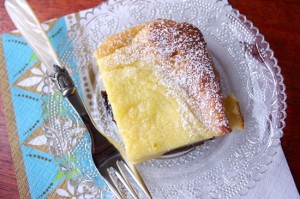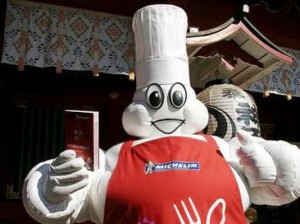David Downie: Truffles in Black and White: Part Four of Four: the Truffle-hunting Pig of Lalbenque
by David Downie
 At Lalbenque, 10 kilometers southeast of Le Montat in southwest France, legendary truffle-hunter Marthe Delon awaited me with her spotted pig.
At Lalbenque, 10 kilometers southeast of Le Montat in southwest France, legendary truffle-hunter Marthe Delon awaited me with her spotted pig.
“This is Kiki the 59th,” Marthe laughed. “Every year I change pigs, they grow too big, but I always name them Kiki.”
Delon, a larger-than-life character now in her eighties, was famous for her truffle omelettes when she was the cook at Lalbenque’s Lion d’Or café, a job she held for 30 years. In her kitchen, she showed me how to store eggs and truffles side by side in a sealed container. “After a day or so the truffle penetrates the eggshell, and that’s the secret of great truffle omelette. The other secret is to put in lots of truffle—a good 10 grams per omelette.”
Before widespread spore-impregnation started in the 1980s, Delon said, she rarely found brumales. Truffle growers used “natural” propagation methods: host trees grew from acorns taken from known truffle-bearing oaks and were replanted in spore-rich areas, a continual process.
 For Marthe, lack of summer rainstorms is the key to falling harvests. Dogs, too, may be part of the problem. “Everyone had pigs, you ate them afterwards, like my Kikis. No need to train them, they love truffles, but only ripe truffles, so they don’t dig up immature ones the way dogs do,” she said, pawing at the air. “How are immature truffles supposed to reproduce?”
For Marthe, lack of summer rainstorms is the key to falling harvests. Dogs, too, may be part of the problem. “Everyone had pigs, you ate them afterwards, like my Kikis. No need to train them, they love truffles, but only ripe truffles, so they don’t dig up immature ones the way dogs do,” she said, pawing at the air. “How are immature truffles supposed to reproduce?”
A freezing wind blew down Lalbenque’s slanting main street as sellers set out wooden benches and wicker baskets for the town’s century-old Tuesday truffle market, held from early November to mid-March. Deals were being done quietly even before the whistle blew at precisely 2:30pm, officially opening the market. Wholesale buyers, chefs and individuals inspected the truffles, which are always sold by the panier (basketful), dickering with sellers for each panier then scribbling offers on paper strips. When a seller pocketed a paper strip it signaled a sale. After a ten-minute flurry of hands, baskets and paper strips the market was over. From parked cars wholesale buyers took out old-fashioned scales, checked the weight of their purchases and paid sellers.
 Scrupulously noting the day’s 92 basketfuls, totaling 45 kilos, veteran French government agricultural statistics recorder Odet Bazalgues tipped back his cap as he spoke to me. “Down from a year ago,” he sighed, tapping his notebook. “Again.” Tons of truffles used to be traded weekly in Lalbenque, he remarked. “It’s still among France’s main markets. Wholesale prices for the rest of the country are set here.” The day’s top-quality truffles sold for 850 euros per kilo. “Good news?” Bazalgues ironized. “Fewer brumales this season.”
Scrupulously noting the day’s 92 basketfuls, totaling 45 kilos, veteran French government agricultural statistics recorder Odet Bazalgues tipped back his cap as he spoke to me. “Down from a year ago,” he sighed, tapping his notebook. “Again.” Tons of truffles used to be traded weekly in Lalbenque, he remarked. “It’s still among France’s main markets. Wholesale prices for the rest of the country are set here.” The day’s top-quality truffles sold for 850 euros per kilo. “Good news?” Bazalgues ironized. “Fewer brumales this season.”
Two days later, at the Thursday truffle market in nearby Limogne-en-Quercy, I witnessed similar rites and an even lower melanosporum yield, and returned to Cahors with grave concerns about the future of truffles.
Housed within Cahors’ Hôtel Terminus, Le Balandre is a handsome, century-old restaurant; both are owned and operated by chef Gilles Marre, his brother Laurent, a sommelier, and their families. Cheerful and plump, Marre is celebrated for his truffle recipes. To start, he served me exquisite Belle Epoque-style poached eggs and foie gras in puff pastry with shaved truffles, the house specialty since before World War One. Next came a heady shepherd’s pie of leeks, potatoes, bacon and truffles. As I finished my meal with an extraordinary glace aux truffes that looked and even tasted like earthy chocolate chip ice cream, I gazed at the restaurant’s stained glass and polished brass and felt I was on the deck of a truffle Titanic.
 Marre agreed with others I had spoken to that the French and Italian passion for truffles showed no signs of abating. “Scarcity is the prime worry,” he said.
Marre agreed with others I had spoken to that the French and Italian passion for truffles showed no signs of abating. “Scarcity is the prime worry,” he said.
Scarcity is likely to increase unless truffle plantations worldwide succeed. The truffle axis, it appears, may gradually shift from Italy and France to Spain, America, China and New Zealand, and more competitive, less flavorful truffle species may well prevail. What does the future hold for the black and white truffles of France and Italy? Current trends suggest that global consumers may actually come to prefer “milder” truffles such as Chinese indicum and their relatively low prices. European truffles appear destined to become ever more a rare delicacy reserved to the lucky few.
Related articles: David Downie: Truffles in Black and White: Part Two, Truffle Hunting in Piedmont, David Downie: Truffles in Black and White: Part Three: the Truffle Heartland of Southwest France.
The photos in this series of articles of truffles were taken by Alison Harris. You can see the entire set as a slide show in Food Art: Behind the Scenes of the Noble Truffle, food photography by Alison Harris.
|
|


































